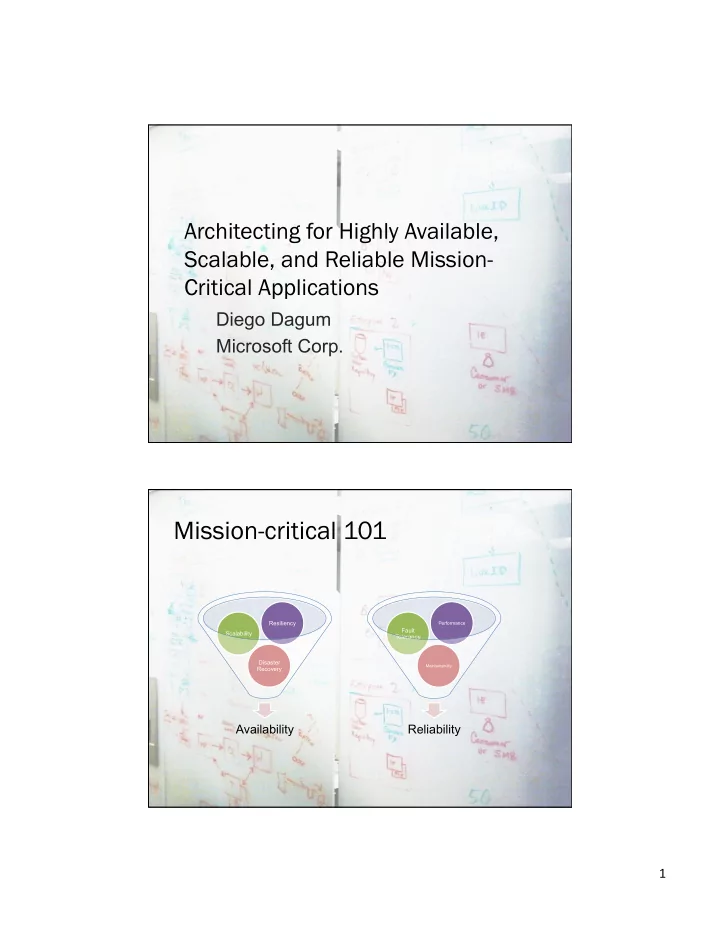

Architecting for Highly Available, Scalable, and Reliable Mission- Critical Applications Diego Dagum Microsoft Corp. Mission-critical 101 Resiliency Performance Fault Scalability Tolerance Disaster Maintainability Recovery Availability Reliability 1
Agenda • Mission-critical 101 (just seen) • Scalability • Failover • Performance • Application health • Fault-tolerance mindsets Scalability Scaling up, out $$ p 10,000 u e l a c s 5,000 2,000 1,000 throughput 2
Scalability Scaling up, out $$ p 10,000 u e l a c s 5,000 2,000 scale up comfort 1,000 area throughput Scalability Scaling out. Redundant approach W/ Session Affinity Resiliency Performance database server 1 load client tier service 1 server 2 balancer W/O Session Affinity service p server n Resiliency Performance server tier back ends 3
Scalability Scaling out. Partitioned approach database server 1 server 1 load load client tier service 1 server 2 server 2 balancer balancer service m server n server p web tier business tier back ends Performance Scalability Aftermath Impact on resiliency and performance Resiliency Performance stateful server stateless server DEAD END? 4
Resiliency Server failover and state management • Server-side – In memory stateful server stateless server – Database – Distributed caching • Client-side – Managed desktops – Unmanaged desktops State Management for Failover Keeping state in the client-side DMZ managed database desktop server 1 VPN load managed service 1 server 2 balancer desktop unmanaged service p server n desktop B2B server tier back ends 5
State Management for Failover Keeping state in a managed client-side database server 1 load managed service 1 server 2 balancer desktop service p server n B2B server tier back ends Scalability State Management for Failover Keeping state in a managed client-side database server 1 load managed service 1 server 2 balancer desktop service p server n B2B server tier back ends Scalability 6
State Management for Failover Keeping state in an unmanaged client-side database server 1 load unmanaged service 1 server 2 balancer desktop service p server n B2B server tier back ends Scalability Scalability Aftermath Impact on performance DEAD END? 7
Scalability Aftermath Impact on performance • Asynchronous execution HIGHWAY • Event-driven Architectures (EDA) ENTRANCE • Parallel execution Performance Asynchronous execution (pull model) Collaborator Collaborator Invoker Worker 1 2 [1..n] Scalability Performance 8
Performance Asynchronous execution (push model) Collaborator Collaborator Invoker Worker 1 2 Scalability Performance Performance Event-driven Architecture (EDA) Process Process 1 B Process C A 3 2 5 Process E 4 Process Process F D 8 9 6 7 Process Process Process I G H request-response approach 9
Performance Event-driven Architecture (EDA) Process Process 1 B Process C A 1 2 3 Process E 2 Process Process F D 3 1 1 2 Process Process Process I G H event-driven approach Performance Event-driven Architecture (EDA) Process Process 1 B Process C A 2 2 3 Process E 1 Process Process F D 1 1 3 4 Process Process Process I G H hybrid request, event-driven approach 10
Performance Parallelism: shared memory model Process Process Process Process A B C D Bus I/O Memory ports Performance Parallelism: distributed memory model Process Process B C Process Process A D Interconnection Network Process Process F E 11
Performance Parallelism: task/channel model 1 0 // Show Rectangles that are the selected colors. 2 foreach (string color in args.AddedItems) 3 if (GetRectangle(color) == null) Rectangle aRect = new Rectangle(); { aRect.Fill = (Brush) ConvertFrom(color); 1 { rectanglesPanel.Children.Add(aRect); aRect.Tag = color; <StackPanel Margin="10"> <Button Content=“Select" /> <Button Content=“Select all" /> <Button Content="Unselect" /> <Button Content=“Unselect all" /> } } </StackPanel> 4 2 Health and Instrumentation Stopping issues before they stop us Scenario Test Environment Requirement Goal Home page Perf Environment #1 2s 1.5s Search results page – 10 results Perf Environment #1 3s 2s Checkout complete Perf Environment #1 5s 4s E#1 Machine CPU RAM Disk Network Client Dell WS 650 1P 2.2 Ghz 1GB 7.5k eSata (100 GB) 600kb App Server Dell PE 6650 4P 2.2 Ghz 4GB 2x15k RPM SCSI 1Gb 3 x 7.2 K SATA (480 GB) Database 15 x 7.2 k SATA2 (3 TB) HP DT 9250 8P 2.6 Ghz 16GB 1Gb Application Data Size 1,000 restaurants, 50,000 menu items, 1,500 orders Work load 1,000 virtual users 100 home pages/sec Throughput 50 searches/sec 2 checkouts/sec 12
Fault-Tolerance Thank You!! 13
References • Application Architecture Guidelines 2 nd Edition, Chapter 5 “Deployment Patterns”, J.D. Meier et al. (2009) • Application Architecture Guidelines 2 nd Edition, Chapter 7 “Quality Attributes”, J.D. Meier et al. (2009) • Performance Testing Guidance for Web Applications, J.D. Meier (2007) • Distributed Caching: Microsoft Project Code Named “Velocity” • Selecting the Right Virtualization Technology (2008) • Backup and Disaster Recovery for Server Virtualization, Adam Fazio (2008) • Asynchronous Programming Design Patterns (2007) • Multithreaded Programming with the Event-based Asynchronous Pattern (2007) • Using Events in Highly Distributed Architectures, David Chou (2008) • MSDN Magazine on Parallel Execution (2008) • Developing Parallel Programs, Ranjan Sen, PhD (2008) • Design for Operations • Design Guidelines for Exceptions (2007) • Exceptions and Performance (2007) 14
Recommend
More recommend